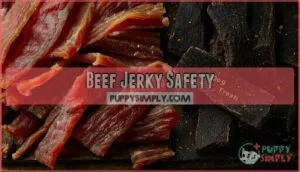This site is supported by our readers. We may earn a commission, at no cost to you, if you purchase through links.

But don’t do it. Most human beef jerky is loaded with salt, spices, and preservatives that can upset your pup’s stomach or even harm their kidneys.
Ingredients like garlic, onion powder, or xylitol, often hidden in jerky, are toxic to dogs. Sure, they’d wag their tail for a taste, but it’s a slippery slope to health issues.
Instead, stick to dog-specific jerky treats or plain, unseasoned beef. Your furry friend will still feel spoiled, and you’ll avoid an unnecessary trip to the vet. Choose wisely!
Table Of Contents
- Key Takeaways
- Beef Jerky Safety
- Can Dogs Eat Human Jerky
- Dangers of Human Jerky
- Healthy Jerky Alternatives
- Feeding Jerky Safely
- Beef Jerky Nutrition
- Jerky and Dog Health
- Safe Jerky Treats
- Jerky Risks and Precautions
- Responsible Jerky Feeding
- Frequently Asked Questions (FAQs)
- Can dogs eat jerky?
- Is beef jerky bad for dogs?
- Can dogs eat beef jerky sticks?
- Can dogs eat Jack Link beef jerky?
- Can dogs eat Slim Jim beef jerky?
- Can dogs eat peppered beef jerky?
- What kind of beef jerky can dogs eat?
- Does beef jerky provide any health benefits for dogs?
- How much beef jerky should I give my dog?
- Is it safe to give my dog homemade beef jerky?
- Conclusion
Key Takeaways
- Don’t feed your dog human beef jerky—most brands are packed with harmful salt, spices like garlic and onion, and preservatives.
- Stick to plain, unseasoned, or dog-specific jerky treats to avoid health risks like sodium poisoning or toxic reactions.
- Homemade jerky can be a safe option if you use lean beef, skip salt and spices, and control the ingredients.
- Always monitor your dog after giving jerky to check for allergies or digestive issues, and consult a vet if unsure.
Beef Jerky Safety
In the case of beef jerky, not all types are safe for your furry friend.
Human jerky often contains harmful ingredients, so it’s important to choose options designed specifically for dogs.
Types of Beef Jerky
Beef jerky comes in various types, but not all are safe for dogs.
Here’s a quick breakdown:
- Homemade Jerky: Safest, with controlled ingredients.
- Plain Jerky: Avoid salt and spices for dogs.
- Commercial Jerky: Check for dog-specific options.
- Organic Jerky: Made from grass-fed beef, minimal additives.
- Flavored Jerky: High-risk; contains harmful spices.
Stick to safe jerky!
Risks of Human Beef Jerky
Human jerky can be risky for dogs due to toxic ingredients like garlic or onion, and excessive sodium content that may lead to Sodium Poisoning.
Beware of human jerky—spices like garlic and onion, plus high sodium, pose serious risks to your furry friend’s health!
Spices and preservatives irritate their system, while additive concerns increase health risks.
Bacterial contamination or a choking hazard adds to jerky risks. Always keep your pup away from these flavored, salty snacks for their safety.
Benefits of Dog-Specific Jerky
You might think all jerky is alike, but dog-specific jerky is a hero for your pup’s health.
Packed with high protein for muscle support, it’s nutrient-rich and promotes dental health while chewing.
These treats are low in fat, supporting weight control, and their long shelf life makes them a convenient treat.
Always choose jerky for dogs to keep your furry friend safe.
Can Dogs Eat Human Jerky
Sharing human beef jerky with your dog might seem harmless, but it’s not the best snack choice.
The main issue lies in the jerky ingredients, many of which are loaded with sodium, which can affect your dog’s health.
Too much salt content might cause dehydration or even salt toxicity. Worse, some jerky contains spice toxicity risks from ingredients like onion or garlic powder, which are toxic foods dogs should avoid.
While your favorite snack may be packed with flavor, it’s not worth endangering your pup’s well-being. If you’re looking for safe alternatives, stick to plain, unseasoned beef jerky made specifically for dogs or homemade treats without harmful additives.
When in doubt, follow veterinarian advice to keep your furry friend happy and healthy.
Dangers of Human Jerky
You might think sharing your beef jerky with your dog is harmless, but it’s not that simple.
Human jerky often contains high salt, spices, and additives that can be dangerous for your furry friend.
High Salt Content
Too much salt in human jerky can harm dogs.
High sodium content leads to dehydration risks, salt toxicity, and even salt poisoning.
Watch for symptoms like vomiting, excessive thirst, or seizures.
Keep your pup safe by following these tips:
- Check for low sodium content.
- Limit treats to safe amounts.
- Prioritize dog jerky over human snacks.
- Provide enough water intake.
- Avoid salty foods entirely to prevent salt poisoning.
Toxic Spices and Seasonings
Spices in human jerky are risky for dogs.
Onion toxicity and garlic concerns can harm red blood cells, leading to weakness. Pepper risks digestive upset, and xylitol dangers can trigger hypoglycemia.
While spice removal may seem helpful, curing and marination embed toxic ingredients. It’s best to keep flavored jerky away—dogs don’t need these risky extras!
Preservatives and Additives
After toxic spices, let’s talk about preservatives and additives lurking in human beef jerky.
Chemical preservatives and artificial flavors might keep it tasty for humans, but for dogs, they’re risky.
Additive sensitivities can trigger issues, and sodium nitrite or coloring agents bring hidden dangers.
Even small amounts of these ingredients could harm your pup, making dog-specific treats the safer choice.
Healthy Jerky Alternatives
If you’re looking for healthier jerky options for your dog, stick to homemade recipes or treats made specifically for pets.
These choices avoid harmful additives and give your furry friend a snack that’s both safe and satisfying.
Homemade Beef Jerky
Homemade jerky is a safer option for dogs, but stick with simple, dog-friendly recipes.
Use lean beef, avoid onion or garlic, and skip the salt. A DIY jerky made just for your pup guarantees control over ingredients and freshness.
Many owners prefer to buy pre-made jerky options for convenience.
Store it in an airtight container, and remember—jerky for dogs should always prioritize safe recipes and careful preparation methods.
Dog-Specific Jerky Brands
If you’re exploring safer options, dog-specific jerky is your go-to.
Brands like BarkBox and Blue Buffalo focus on ingredient quality and nutritional value, while others like Rocco & Roxie prioritize sourcing practices.
Always consider recall history and brand reputation before choosing any jerky for dogs.
Many retailers sell various dog jerky and these customized treats make great dog treats without risking your pup’s health or happiness!
Natural Ingredients
When choosing beef jerky for dogs, stick with additive-free, organic options.
Grass-fed benefits and simple recipes guarantee safe jerky ingredients. Avoid toxic foods for dogs, like onion or garlic, often found in human food.
Ingredient sourcing matters—quality jerky supports dog health. Remember, human jerky isn’t ideal, but natural, plain varieties without preservatives can work in moderation.
Always prioritize safety!
Feeding Jerky Safely
When feeding jerky to your dog, you’ll want to keep portions small and stick to plain, unsalted options.
Always check the ingredients to avoid harmful additives, and remember that moderation is key for a happy, healthy pup.
Moderation is Key
Regarding jerky for dogs, moderation is key.
Stick to small portions and limit treat frequency for balanced nutrition.
Overindulging can upset calorie intake and dog health.
Follow these guidelines:
- Treats: 10% of daily calories max.
- Match portions to size.
- Offer once or twice weekly.
- Watch calorie intake.
- Focus on a balanced diet.
Choosing Safe Ingredients
Don’t get tricked by ingredient labels that sound safe—some sneak in toxic additives.
Stick to natural proteins like grass-fed beef without harmful ingredients.
Avoid toxic foods dogs hate, like garlic or onion powder.
Here’s a quick guide:
| Do Choose | Avoid These |
|---|---|
| Grass-Fed Beef | Garlic or Onion |
| Safe Spices | Artificial Sweeteners |
| Natural Proteins | High Sodium Content |
| Dog Food Ingredients | Preservatives |
Avoiding Choking Hazards
Jerky texture can pose a choking hazard, especially for smaller dogs or those with fast chewing habits.
Size matters—cut dog jerky into bite-sized pieces to reduce risks.
Always supervise during snack time and observe how they eat. If your pup gulps treats, opt for softer, safe alternatives.
Beef jerky dogs love isn’t worth the risk without dog treat safety tips in mind.
Beef Jerky Nutrition
You might think beef jerky is a protein-packed treat, but not all jerky is created equal.
For dogs, the right balance of nutrients and the absence of harmful additives are key.
High Protein Content
Beef jerky offers high protein levels, making it great for muscle development and tissue repair in dogs.
Protein is an energy source that supports an active dog diet and promotes satiety benefits, helping pups feel full longer.
While it’s a good diet supplement, make certain jerky is plain and dog-specific to match nutritional needs without risking health.
Many jerky products contain toxic ingredients like onion and garlic.
Essential Vitamins and Minerals
Strong jerky nutrition isn’t just about protein—it’s packed with vitamins and minerals dogs need.
Iron benefits their energy, magnesium importance keeps systems in sync, and zinc sources support shiny coats.
Don’t overlook:
- Vitamin absorption for overall wellness.
- Mineral deficiencies leading to health problems.
- Copper helping immune function.
- Nutrients found in beef liver, jerky’s powerhouse ingredient.
Feed wisely for healthy dog nutrition.
Low-Calorie Profile
A slim waistline for your pup starts with understanding calorie density.
Low-calorie dog jerky is perfect for weight management when used in moderation.
Lean jerky offers protein without unnecessary fat, making it a healthier choice than calorie-packed treats.
Check out this comparison:
| Treat Type | Calories (per oz) | Best For |
|---|---|---|
| Dog-Specific Jerky | 30-50 | Healthy snack options |
| Lean Homemade Jerky | 25-40 | Controlled ingredients |
| Commercial Treats | 80+ | Occasional indulgence |
Jerky and Dog Health
You might think beef jerky is a harmless snack to share with your dog, but it’s not always that simple.
Certain ingredients and textures can affect your dog’s health, causing issues like allergies or digestive problems.
Allergies and Sensitivities
If your pup shows signs of beef allergy or jerky intolerance, like itching or upset tummy, it’s time to rethink treats.
Some breeds have higher ingredient sensitivity, making dog allergies more common.
Food allergies could lead to reaction symptoms, even rare anaphylaxis.
Stick to single-ingredient dog treat alternatives, and when in doubt, call your vet to monitor for changes.
Digestive Issues
Sometimes, jerky treats can cause dog digestive health problems like an upset stomach or dog diarrhea.
High sodium or spices can trigger vomiting signs or food intolerance, leading to gastrointestinal upset.
Flavored jerky, especially human kinds, brings a pancreatitis risk.
Stick to plain, dog-safe options to keep things running smoothly.
Always watch for dog vomiting or other signs of trouble post-snack, as high sodium and spices can be particularly problematic.
Nutritional Deficiencies
If bad jerky for dogs messes up their stomachs, it can also mess up dog nutrition.
Human snacks often lead to incomplete nutrition—too much salt, not enough protein, and zero fiber.
Vitamin deficiencies and mineral imbalances can show up too.
Plain jerky, specifically for dogs, keeps nutrients balanced, supporting their bodies without risking their health, providing complete nutrition.
Safe Jerky Treats
When choosing a jerky treat for your dog, stick to plain, unseasoned options or those specifically made for pets.
Look for trusted brands with low sodium and no harmful additives to keep your pup safe and happy.
Plain Unseasoned Jerky
Plain, unseasoned beef jerky can work as an occasional treat for dogs if prepared with safety in mind.
For safe preparation:
- Use minimal processing to retain nutritional value.
- Source quality ingredients without harmful additives.
- Follow storage guidelines to prevent spoilage.
Always prioritize plain jerky without spices, ensuring it’s simple, healthy, and digestible.
Moderation is key for keeping treats safe.
Low-Sodium Options
Low-sodium options are a smart choice when picking jerky for dogs.
High sodium content can harm their health, so look for sodium-free jerky or dog-specific jerky with minimal salt.
Homemade jerky recipes allow ingredient control, ensuring a safer snack. Always check labels for sodium levels, and remember, moderation is key.
Safe brands prioritize dogs’ well-being over flavor. For a different approach, consider healthy store-bought treats with balanced nutrition.
Reputable Brands
When choosing jerky for dogs, trusted jerky brands make all the difference.
Look for safe jerky sources with veterinarian recommendations, emphasizing jerky ingredient quality. Opt for dog-friendly jerky like those from reputable companies crafting treats specifically for canine nutrition.
If you’re seeking safe jerky products, online resources can help. Brands like Zuke’s or Wellness offer beef jerky that’s safe for dogs, ensuring it’s a treat—not trouble—in their diet.
Jerky Risks and Precautions
Feeding your dog human beef jerky can seem harmless, but it comes with risks you shouldn’t ignore.
Ingredients like xylitol, garlic, onion, and high salt levels can lead to serious health problems.
Xylitol Toxicity
While exploring safe jerky treats, be cautious about xylitol, a common ingredient in artificial sweeteners.
Found in gum and mints, xylitol causes hypoglycemia, liver failure, and severe toxicity symptoms in dogs.
Even small amounts can lead to dog poisoning. Keep jerky free from toxic foods dogs shouldn’t eat, and check labels.
Skin allergies are common in some breeds. Have the Pet Poison Helpline handy for emergencies.
Garlic and Onion Poisoning
Garlic and onion might seem harmless, but these common ingredients are toxic foods for dogs.
Even a small toxic dosage can damage red blood cells, leading to anemia and breathing problems.
Symptoms onset includes vomiting, weakness, and lethargy. Over time, organ damage can occur.
Always check jerky ingredients carefully to avoid accidental dog poisoning from garlic, onion, or sodium poisoning.
Dehydration and Salt Toxicity
Too much sodium in beef jerky can spell trouble for dogs.
Excessive sodium content leads to dehydration and even hypernatremia, a condition causing confusion or seizures.
Smaller breeds are more sensitive, as size matters regarding jerky portions.
Always make certain water intake is adequate, and if unsure, seek veterinary advice.
Your dog’s health is worth it!
Responsible Jerky Feeding
When feeding your dog jerky, stick to options made specifically for them and avoid human varieties loaded with harmful ingredients.
Always check with your vet to guarantee your furry friend stays safe and healthy while enjoying this treat.
Consulting a Veterinarian
When you’re unsure about jerky suitability for your dog, veterinarian advice is your best bet.
Specific conditions like food allergies or breed predispositions can determine if it’s safe. An online vet consultation makes quick allergy concerns easier to address.
Always check with a vet before adding jerky to your dog’s diet—it’s the safest move! Many jerky brands contain toxic ingredients that can be harmful.
Monitoring Dog Health
Keep an eye on your dog after giving jerky treats.
Watch for allergy symptoms, digestive changes, or unusual behavioral shifts.
Check hydration levels, especially with salty treats, and note any activity changes.
If you see concerning dog symptoms, ask for veterinarian advice.
Regular monitoring guarantees jerky concerns don’t turn serious.
Is jerky safe? Observation is key!
Avoiding Human Jerky
You might think sharing jerky is safe, but human beef jerky poses jerky dangers for dogs.
Harmful ingredients like spices, preservatives, and excess salt content can have toxic effects.
Safer alternatives, like dog-specific jerky, avoid these risks.
Always prioritize reading labels to check for jerky concerns. Stick to plain options crafted for dogs to keep your pup healthy.
Frequently Asked Questions (FAQs)
Can dogs eat jerky?
Jerky for dogs can be a treat, but it should be plain, unseasoned, and low in sodium.
Skip spicy or human-grade varieties—they’re loaded with harmful ingredients like garlic or onion.
Stick to dog-specific options.
Is beef jerky bad for dogs?
Beef jerky can harm dogs if it’s human-grade, with high sodium, spices, or additives like garlic or onion.
Stick to dog-specific jerky or plain homemade versions to guarantee their safety and avoid health risks.
Can dogs eat beef jerky sticks?
Dogs can eat plain, unseasoned beef jerky sticks made specifically for pets.
Avoid jerky sticks meant for humans, as they often contain harmful ingredients like garlic, onion, or excessive salt.
Always double-check the label for safety.
Can dogs eat Jack Link beef jerky?
Ever wonder if Jack Link’s beef jerky is safe for dogs?
It’s not.
High sodium, spices like garlic and onion powder, and preservatives can harm your pup.
Stick to dog-specific treats for safety.
Can dogs eat Slim Jim beef jerky?
Slim Jims aren’t a safe snack for dogs.
They’re loaded with salt, spices, and preservatives that can harm your pet.
Stick to dog-friendly treats with simple, natural ingredients to keep your furry friend healthy.
Can dogs eat peppered beef jerky?
Peppered beef jerky isn’t safe for dogs.
Spices like black pepper can upset their stomachs, and high sodium levels pose health risks.
Stick to plain, dog-specific treats to keep your pup happy and healthy.
What kind of beef jerky can dogs eat?
Think lean, plain, and simple—dogs can enjoy beef jerky made specifically for them or homemade versions without spices, salt, or preservatives.
Skip the fancy flavors and opt for natural, unsalted options in moderation.
Does beef jerky provide any health benefits for dogs?
Beef jerky offers high protein, supports muscle growth, and can promote dental health through chewing.
However, stick to plain, dog-safe options without salt or seasonings, and always limit portions for a healthy, happy pup!
How much beef jerky should I give my dog?
In the case of beef jerky for dogs, less is more.
Stick to dog-specific jerky, giving small pieces occasionally—no more than one piece daily for small dogs.
Always monitor them and watch for reactions.
Is it safe to give my dog homemade beef jerky?
Yes, homemade beef jerky can be safe for your dog if it’s plain, unsalted, and free of spices or additives.
Stick to simple recipes and avoid harmful ingredients like garlic, onion, or excessive salt.
Conclusion
Sharing human beef jerky with your dog might seem like a harmless snack moment, but it’s best to think twice.
While the protein is tempting, most human varieties are packed with salt, spices, and preservatives that aren’t dog-friendly.
Toxic ingredients like garlic, onion powder, or xylitol can cause serious health issues for your pup.
Stick to plain, unseasoned options or dog-specific jerky treats instead. Your furry friend will thank you—with tail wags, not trips to the vet!
- https://www.justanswer.com/dog-health/h7ghl-doggie-bag-human-beef-jerky.html
- https://www.quora.com/Is-it-safe-for-dogs-to-eat-beef-sticks-or-jerky
- https://www.cadetpet.com/dog-basics/can-dogs-eat-beef-jerky
- https://www.twochicksjerky.com/blogs/learn/can-dogs-eat-beef-jerky
- https://campfiretreats.com/blogs/campfire-tales/can-dogs-eat-jerky?srsltid=AfmBOorzYGyntmmoTHkmagRBDGDKrZ29wWybRPmnPoNlxDpUI363ZH2I




















